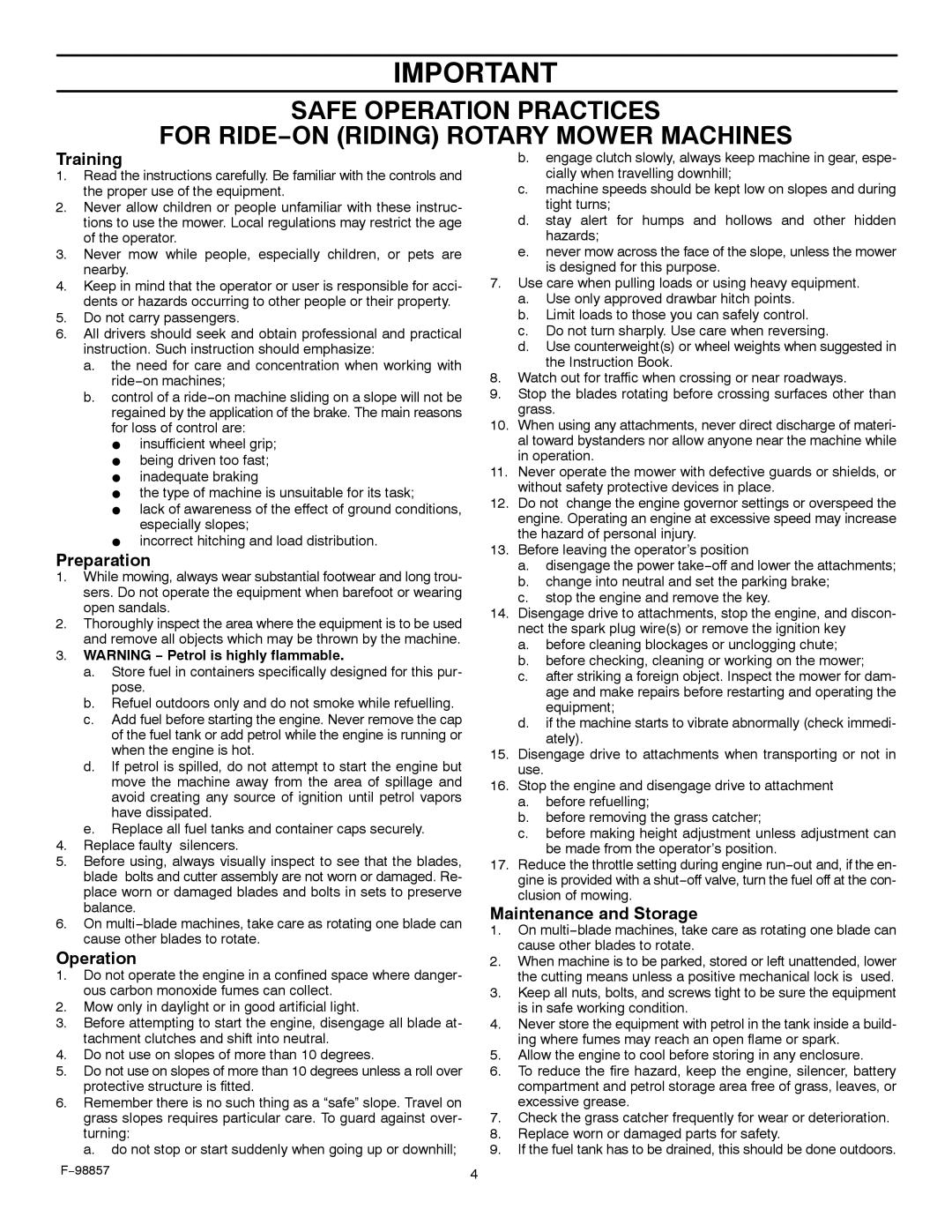IMPORTANT
SAFE OPERATION PRACTICES
FOR RIDE−ON (RIDING) ROTARY MOWER MACHINES
Training
1.Read the instructions carefully. Be familiar with the controls and the proper use of the equipment.
2.Never allow children or people unfamiliar with these instruc- tions to use the mower. Local regulations may restrict the age of the operator.
3.Never mow while people, especially children, or pets are nearby.
4.Keep in mind that the operator or user is responsible for acci- dents or hazards occurring to other people or their property.
5.Do not carry passengers.
6.All drivers should seek and obtain professional and practical instruction. Such instruction should emphasize:
a.the need for care and concentration when working with ride−on machines;
b.control of a ride−on machine sliding on a slope will not be regained by the application of the brake. The main reasons for loss of control are:
F insufficient wheel grip; F being driven too fast; F inadequate braking
F the type of machine is unsuitable for its task;
F lack of awareness of the effect of ground conditions, especially slopes;
F incorrect hitching and load distribution.
Preparation
1.While mowing, always wear substantial footwear and long trou- sers. Do not operate the equipment when barefoot or wearing open sandals.
2.Thoroughly inspect the area where the equipment is to be used and remove all objects which may be thrown by the machine.
3.WARNING − Petrol is highly flammable.
a.Store fuel in containers specifically designed for this pur- pose.
b.Refuel outdoors only and do not smoke while refuelling.
c.Add fuel before starting the engine. Never remove the cap of the fuel tank or add petrol while the engine is running or when the engine is hot.
d.If petrol is spilled, do not attempt to start the engine but move the machine away from the area of spillage and avoid creating any source of ignition until petrol vapors have dissipated.
e.Replace all fuel tanks and container caps securely.
4.Replace faulty silencers.
5.Before using, always visually inspect to see that the blades, blade bolts and cutter assembly are not worn or damaged. Re- place worn or damaged blades and bolts in sets to preserve balance.
6.On multi−blade machines, take care as rotating one blade can cause other blades to rotate.
Operation
1.Do not operate the engine in a confined space where danger- ous carbon monoxide fumes can collect.
2.Mow only in daylight or in good artificial light.
3.Before attempting to start the engine, disengage all blade at- tachment clutches and shift into neutral.
4.Do not use on slopes of more than 10 degrees.
5.Do not use on slopes of more than 10 degrees unless a roll over protective structure is fitted.
6.Remember there is no such thing as a “safe” slope. Travel on grass slopes requires particular care. To guard against over- turning:
a. do not stop or start suddenly when going up or downhill;
b.engage clutch slowly, always keep machine in gear, espe- cially when travelling downhill;
c.machine speeds should be kept low on slopes and during tight turns;
d.stay alert for humps and hollows and other hidden hazards;
e.never mow across the face of the slope, unless the mower is designed for this purpose.
7.Use care when pulling loads or using heavy equipment.
a.Use only approved drawbar hitch points.
b.Limit loads to those you can safely control.
c.Do not turn sharply. Use care when reversing.
d.Use counterweight(s) or wheel weights when suggested in the Instruction Book.
8.Watch out for traffic when crossing or near roadways.
9.Stop the blades rotating before crossing surfaces other than grass.
10.When using any attachments, never direct discharge of materi- al toward bystanders nor allow anyone near the machine while in operation.
11.Never operate the mower with defective guards or shields, or without safety protective devices in place.
12.Do not change the engine governor settings or overspeed the engine. Operating an engine at excessive speed may increase the hazard of personal injury.
13.Before leaving the operator’s position
a.disengage the power take−off and lower the attachments;
b.change into neutral and set the parking brake;
c.stop the engine and remove the key.
14.Disengage drive to attachments, stop the engine, and discon- nect the spark plug wire(s) or remove the ignition key
a.before cleaning blockages or unclogging chute;
b.before checking, cleaning or working on the mower;
c.after striking a foreign object. Inspect the mower for dam- age and make repairs before restarting and operating the equipment;
d.if the machine starts to vibrate abnormally (check immedi- ately).
15.Disengage drive to attachments when transporting or not in use.
16.Stop the engine and disengage drive to attachment
a.before refuelling;
b.before removing the grass catcher;
c.before making height adjustment unless adjustment can be made from the operator’s position.
17.Reduce the throttle setting during engine run−out and, if the en- gine is provided with a shut−off valve, turn the fuel off at the con- clusion of mowing.
Maintenance and Storage
1.On multi−blade machines, take care as rotating one blade can cause other blades to rotate.
2.When machine is to be parked, stored or left unattended, lower the cutting means unless a positive mechanical lock is used.
3.Keep all nuts, bolts, and screws tight to be sure the equipment is in safe working condition.
4.Never store the equipment with petrol in the tank inside a build- ing where fumes may reach an open flame or spark.
5.Allow the engine to cool before storing in any enclosure.
6.To reduce the fire hazard, keep the engine, silencer, battery compartment and petrol storage area free of grass, leaves, or excessive grease.
7.Check the grass catcher frequently for wear or deterioration.
8.Replace worn or damaged parts for safety.
9.If the fuel tank has to be drained, this should be done outdoors.
F−98857 | 4 |
